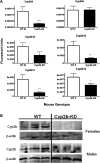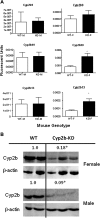Lentiviral-mediated RNAi knockdown yields a novel mouse model for studying Cyp2b function
- PMID: 22083726
- PMCID: PMC3262856
- DOI: 10.1093/toxsci/kfr309
Lentiviral-mediated RNAi knockdown yields a novel mouse model for studying Cyp2b function
Abstract
There are few in vivo knockout models available to study the function of Cyp2 members involved in the metabolism of endogenous and exogenous chemicals. These models may help provide insight into the cytochrome P450s (CYPs) responsible for the detoxification and activation of drugs, environmental toxicants, and endobiotics. The aim of this work is to produce a potent Cyp2b-knockdown (KD) mouse for subsequent study of Cyp2b function. We made a quintuple Cyp2b-KD mouse using lentiviral-promoted short hairpin RNA (shRNA) homologous to all five murine Cyp2b subfamily members (Cyp2b9, 2b10, 2b13, 2b19, and 2b23). The Cyp2b-KD mice are viable, fertile, and without obvious gross abnormalities except for an increase in liver weight. Expression of the three hepatic Cyp2b members, 2b9, 2b10, and 2b13, is significantly repressed as demonstrated by quantitative real-time PCR and Western blotting. The constitutive androstane receptor activator, 1,4-Bis[2-(3,5-dichloropyridyloxy)] benzene (TCPOBOP), was used to determine if shRNA-mediated Cyp2b10 repression could be outcompeted by Cyp2b10 induction. TCPOBOP-treated Cyp2b-KD mice show 80-90% less Cyp2b protein expression than TCPOBOP-treated wild-type (WT) mice, demonstrating that Cyp induction does not outcompete the repressive function of the shRNA. Untreated and TCPOBOP-treated Cyp2b-KD mice are poor metabolizers of parathion compared with WT mice. Furthermore, Cyp2b-KD mice are sensitive to parathion, an organophosphate insecticide primarily metabolized by Cyp2b enzymes, when compared with WT mice. In summary, we designed an shRNA construct that repressed the expression and activity of multiple Cyp2b enzymes. We foresee that this novel Cyp2b-KD mouse model will significantly improve our understanding of the role of Cyp2b enzymes in chemical sensitivity and drug metabolism.
Figures







References
-
- Amacher DE, Schomaker SJ, Burkhardt JE. The relationship among microsomal enzyme induction, liver weight and histological change in beagle dog toxicology studies. Food Chem. Toxicol. 2001;39:817–825. - PubMed
-
- Banks WJ. Applied Veterinary Histology. 3rd ed. St Louis, MO: C V Mosby; 1993.
-
- Beilke LD, Aleksunes LM, Holland RD, Besselsen DG, Beger RD, Klaassen CD, Cherrington NJ. Constitutive androstane receptor-mediated changes in bile acid composition contributes to hepatoprotection from lithocholic acid-induced liver injury in mice. Drug Metab. Dispos. 2009;37:1035–1045. - PMC - PubMed
Publication types
MeSH terms
Substances
Grants and funding
LinkOut - more resources
Full Text Sources
Molecular Biology Databases
Miscellaneous

